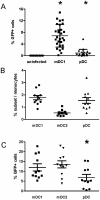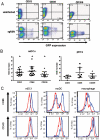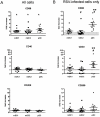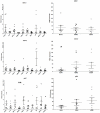Primary human mDC1, mDC2, and pDC dendritic cells are differentially infected and activated by respiratory syncytial virus
- PMID: 21297989
- PMCID: PMC3030580
- DOI: 10.1371/journal.pone.0016458
Primary human mDC1, mDC2, and pDC dendritic cells are differentially infected and activated by respiratory syncytial virus
Abstract
Respiratory syncytial virus (RSV) causes recurrent infections throughout life. Vaccine development may depend upon understanding the molecular basis for induction of ineffective immunity. Because dendritic cells (DCs) are critically involved in early responses to infection, their interaction with RSV may determine the immunological outcome of RSV infection. Therefore, we investigated the ability of RSV to infect and activate primary mDCs and pDCs using recombinant RSV expressing green fluorescent protein (GFP). At a multiplicity of infection of 5, initial studies demonstrated ∼6.8% of mDC1 and ∼0.9% pDCs were infected. We extended these studies to include CD1c(-)CD141(+) mDC2, finding mDC2 infected at similar frequencies as mDC1. Both infected and uninfected cells upregulated phenotypic markers of maturation. Divalent cations were required for infection and maturation, but maturation did not require viral replication. There is evidence that attachment and entry/replication processes exert distinct effects on DC activation. Cell-specific patterns of RSV-induced maturation and cytokine production were detected in mDC1, mDC2, and pDC. We also demonstrate for the first time that RSV induces significant TIMP-2 production in all DC subsets. Defining the influence of RSV on the function of selected DC subsets may improve the likelihood of achieving protective vaccine-induced immunity.
Conflict of interest statement
Figures






Similar articles
-
Lack of Activation Marker Induction and Chemokine Receptor Switch in Human Neonatal Myeloid Dendritic Cells in Response to Human Respiratory Syncytial Virus.J Virol. 2019 Oct 29;93(22):e01216-19. doi: 10.1128/JVI.01216-19. Print 2019 Nov 15. J Virol. 2019. PMID: 31484754 Free PMC article.
-
Autophagy-mediated dendritic cell activation is essential for innate cytokine production and APC function with respiratory syncytial virus responses.J Immunol. 2011 Oct 15;187(8):3953-61. doi: 10.4049/jimmunol.1100524. Epub 2011 Sep 12. J Immunol. 2011. PMID: 21911604 Free PMC article.
-
Differentiation and immune function of human dendritic cells following infection by respiratory syncytial virus.Clin Exp Immunol. 2006 Mar;143(3):513-22. doi: 10.1111/j.1365-2249.2005.03004.x. Clin Exp Immunol. 2006. PMID: 16487251 Free PMC article.
-
Impairment of T cell immunity by the respiratory syncytial virus: targeting virulence mechanisms for therapy and prophylaxis.Curr Med Chem. 2009;16(34):4609-25. doi: 10.2174/092986709789760724. Curr Med Chem. 2009. PMID: 19903147 Review.
-
Respiratory syncytial virus (RSV) evades the human adaptive immune system by skewing the Th1/Th2 cytokine balance toward increased levels of Th2 cytokines and IgE, markers of allergy--a review.Virus Genes. 2006 Oct;33(2):235-52. doi: 10.1007/s11262-006-0064-x. Virus Genes. 2006. PMID: 16972040 Review.
Cited by
-
The specific features of the developing T cell compartment of the neonatal lung are a determinant of respiratory syncytial virus immunopathogenesis.PLoS Pathog. 2021 Apr 28;17(4):e1009529. doi: 10.1371/journal.ppat.1009529. eCollection 2021 Apr. PLoS Pathog. 2021. PMID: 33909707 Free PMC article.
-
Innate Immune Components that Regulate the Pathogenesis and Resolution of hRSV and hMPV Infections.Viruses. 2020 Jun 12;12(6):637. doi: 10.3390/v12060637. Viruses. 2020. PMID: 32545470 Free PMC article. Review.
-
Autophagy-inducing protein beclin-1 in dendritic cells regulates CD4 T cell responses and disease severity during respiratory syncytial virus infection.J Immunol. 2013 Sep 1;191(5):2526-37. doi: 10.4049/jimmunol.1300477. Epub 2013 Jul 26. J Immunol. 2013. PMID: 23894198 Free PMC article.
-
Respiratory Syncytial Virus and Cellular Stress Responses: Impact on Replication and Physiopathology.Viruses. 2016 May 12;8(5):124. doi: 10.3390/v8050124. Viruses. 2016. PMID: 27187445 Free PMC article. Review.
-
Host Responses to Respiratory Syncytial Virus Infection.Viruses. 2023 Sep 26;15(10):1999. doi: 10.3390/v15101999. Viruses. 2023. PMID: 37896776 Free PMC article. Review.
References
-
- Martinez FD. Respiratory syncytial virus bronchiolitis and the pathogenesis of childhood asthma. Pediatr Infect Dis J. 2003;22:S76–S82. - PubMed
-
- Schauer U, Hoffjan S, Bittscheidt J, Köchling A, Hemmis S, et al. RSV bronchiolitis and risk of wheeze and allergic sensitisation in the first year of life. Eur Respir J. 2002;20:1277–1283. - PubMed
-
- Sigurs N, Bjarnason R, Sigurbergsson F, Kjellman B. Respiratory syncytial virus bronchiolitis in infancy is an important risk factor for asthma and allergy at age 7. Am J Resp Crit Care Med. 2000;161:1501–1507. - PubMed
-
- Glezen WP, Taber LH, Frank AL, Kasel JA. Risk of primary infection and reinfection with respiratory syncytial virus. Am J Dis Child. 1986;140:543–546. - PubMed
Publication types
MeSH terms
Substances
Grants and funding
LinkOut - more resources
Full Text Sources
Medical
Research Materials
Miscellaneous

